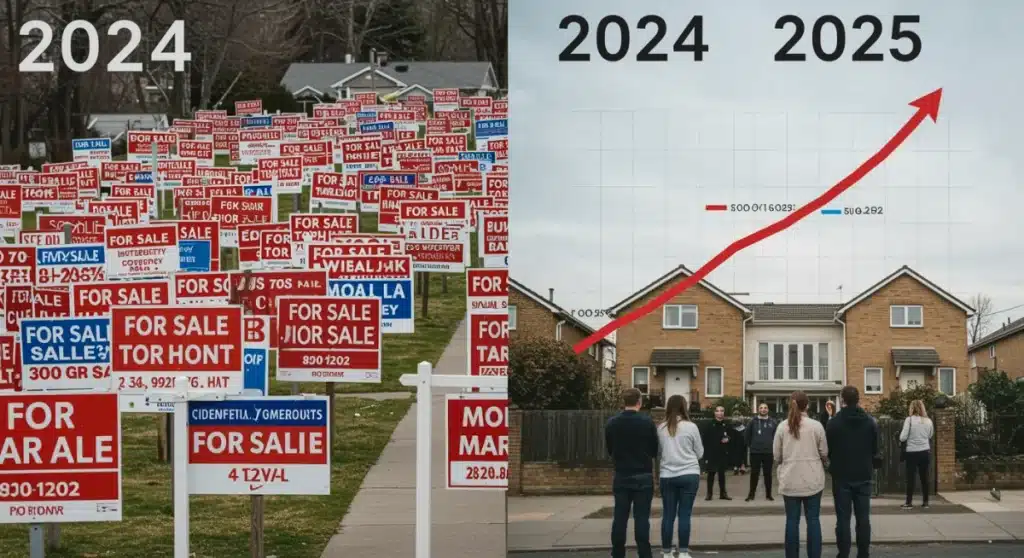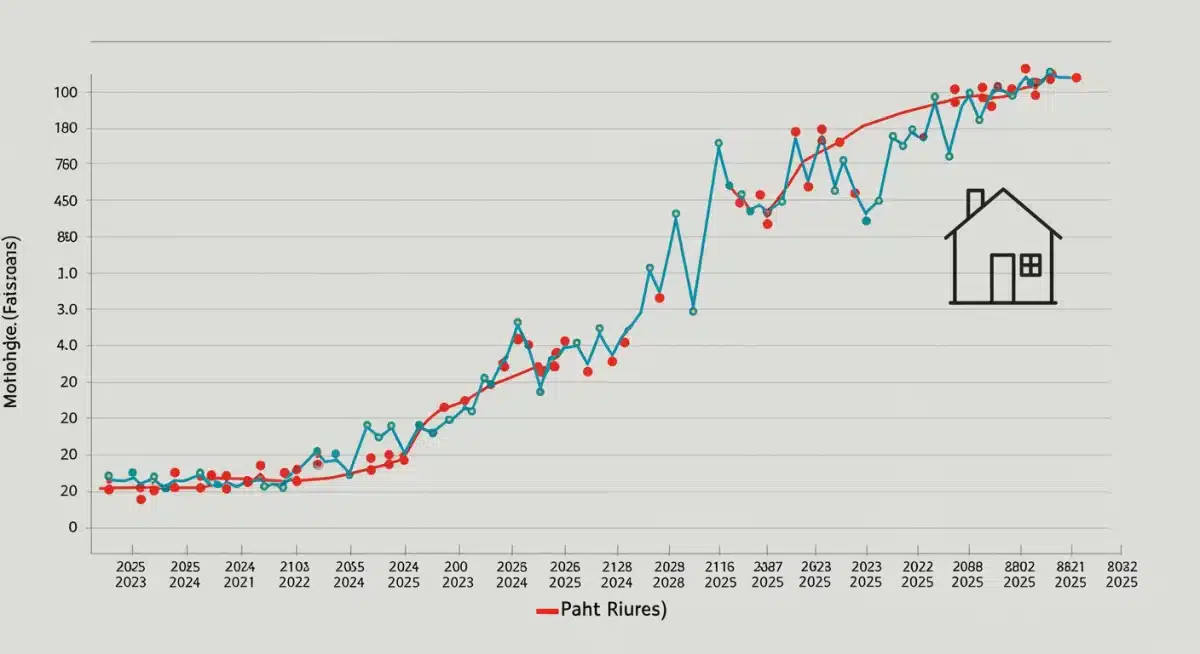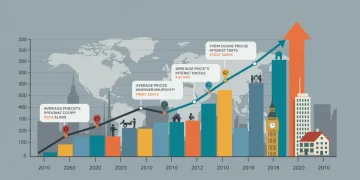2024 vs. 2025 Real Estate Market Dynamics: What’s Changed?

Comparing 2024 vs. 2025 Real Estate Market Dynamics: What’s Changed? reveals a landscape in flux, with significant shifts impacting homeowners, buyers, and investors alike. As we navigate these evolving conditions, understanding the subtle yet profound differences between these two years is crucial for strategic decision-making.
Interest Rate Trajectories and Buyer Behavior
The trajectory of interest rates stands as a primary driver in the evolving real estate market dynamics. In 2024, the market grappled with persistently higher rates, influencing affordability and tempering buyer enthusiasm. As we transition into 2025, expectations for rate stabilization or even slight declines are shaping new buyer behaviors.
Mortgage rates, directly tied to the Federal Reserve’s policies and broader economic indicators, have a profound impact on purchasing power. A marginal shift can translate into hundreds of dollars difference in monthly payments, directly affecting who can afford to buy and where.
Federal Reserve Influence
The Federal Reserve’s stance on inflation and economic growth remains central to interest rate forecasts. Throughout 2024, the Fed maintained a cautious approach, signaling a commitment to price stability. This translated into a period of adjustment for the housing market, as buyers recalibrated their expectations.
- 2024 Rate Environment: Characterized by elevated rates, leading to reduced buyer competition and longer market times in some segments.
- 2025 Rate Outlook: Anticipated stabilization or modest decreases, potentially stimulating demand and revitalizing buyer confidence.
- Impact on Affordability: Even slight rate drops in 2025 could significantly enhance affordability for a broader range of buyers.
Buyer behavior in 2024 often reflected a wait-and-see approach, with many potential purchasers delaying decisions in hopes of more favorable borrowing conditions. This created a peculiar market where demand was present but often paused. Looking to 2025, a shift towards more proactive buying is expected if rates become more predictable and manageable, according to recent market analyses.
Inventory Levels and Housing Supply
The critical issue of housing supply continues to shape the real estate market. While 2024 saw persistent inventory shortages, particularly in desirable urban and suburban areas, 2025 may offer some nuanced changes, though significant relief remains a challenge.
Low inventory levels have been a defining characteristic, driving up prices and intensifying competition in specific market segments. This imbalance between supply and demand has created unique challenges for both buyers and sellers, making transactions more complex.
Construction Activity and New Listings
New construction activity has been a slow but steady contributor to alleviating supply pressures. In 2024, builders faced challenges including high material costs and labor shortages, limiting the pace of new home deliveries. However, projections for 2025 suggest a potential uptick in new listings as construction pipelines mature and economic conditions stabilize.
The influx of new listings, both from new constructions and existing homeowners choosing to sell, will be a key factor in determining market equilibrium. A significant increase could ease price appreciation and offer more choices to buyers.
- 2024 Supply Challenges: Limited new construction starts and reluctance from existing homeowners to sell due to favorable mortgage rates on current properties.
- 2025 Supply Projections: Modest increase in new home completions and a potential rise in existing home listings, influenced by shifting interest rate expectations.
- Regional Disparities: Inventory relief will vary significantly by region, with some areas experiencing more acute shortages than others.
Developers are closely monitoring market signals, adjusting their strategies to meet anticipated demand. The types of homes being built, from single-family residences to multi-family units, will also play a role in addressing the diverse needs of the market. This strategic response is vital for the overall health of the housing sector.
Shifting Demographics and Buyer Preferences
Demographic shifts are continuously reshaping the real estate landscape, with distinct preferences emerging between 2024 and 2025. Younger generations, particularly millennials and Gen Z, are increasingly influential, bringing new priorities to the housing market.
In 2024, a notable trend was the continued demand for suburban living, driven by hybrid work models and a desire for more space. This trend, while still present, is evolving as urban centers show signs of revitalization and new housing options emerge.
Generational Buying Trends
Millennials, now firmly in their prime homebuying years, are seeking affordability and convenience. Their preferences often lean towards move-in-ready homes with modern amenities. Gen Z, on the other hand, is just beginning to enter the market, with a strong emphasis on sustainability and technologically integrated homes.
The impact of these generational preferences is profound. Builders and real estate agents are adapting their offerings to cater to these evolving demands, influencing everything from home design to community planning.
- Millennial Influence: Continued search for affordable housing, often balancing urban access with suburban space.
- Gen Z Entry: Growing interest in sustainable homes, smart technology, and community-oriented developments.
- Changing Urban Appeal: Renewed interest in city living in 2025, particularly in areas offering mixed-use developments and vibrant cultural scenes.
Remote work capabilities, a significant factor in 2024, are still relevant but are being integrated into a broader lifestyle choice rather than being the sole determinant. This has led to a diversification of preferred locations, including secondary cities and exurban communities that offer a balance of affordability and quality of life.

Technological Innovations and Market Efficiency
Technological advancements are rapidly transforming the real estate sector, enhancing market efficiency and changing how properties are bought, sold, and managed. The period from 2024 to 2025 showcases an acceleration in the adoption of digital tools and platforms.
In 2024, virtual tours and online listings became standard practice, streamlining the initial stages of property search. Moving into 2025, the integration of AI and data analytics is poised to offer even greater precision and personalization in real estate transactions.
AI and Data Analytics Integration
Artificial intelligence is increasingly being utilized for predictive analytics, helping to forecast market trends and property valuations with greater accuracy. This allows both buyers and sellers to make more informed decisions, reducing uncertainty.
Data analytics provides insights into neighborhood demographics, school ratings, crime rates, and future development plans, offering a comprehensive view beyond just property specifics. This level of detail was less accessible in previous years.
- Automated Valuation Models (AVMs): More sophisticated and accurate in 2025, providing real-time property assessments.
- Personalized Property Recommendations: AI algorithms offer tailored suggestions based on individual preferences and historical data.
- Blockchain for Transactions: Emerging as a secure and transparent method for property transfers, reducing fraud and processing times.
The role of augmented reality (AR) and virtual reality (VR) in property viewing is also expanding. These technologies allow potential buyers to virtually experience a property, even customizing interiors, without physically being there. This significantly broadens the reach of listings and enhances the buyer experience.
Regulatory Changes and Economic Policies
Regulatory changes and evolving economic policies play a significant role in shaping the real estate market between 2024 and 2025. Government interventions, environmental regulations, and local zoning laws directly impact development, affordability, and market accessibility.
In 2024, policy discussions often centered on housing affordability crises and the need for increased supply. As we move into 2025, the focus may shift towards sustainable development and equitable housing solutions, according to various policy think tanks.
Impact of Local and Federal Policies
Federal housing policies, including those related to mortgage lending and housing subsidies, directly influence the financial landscape for buyers. Changes in these policies can either stimulate or dampen demand, affecting market liquidity.
At the local level, zoning ordinances, building codes, and environmental regulations dictate what can be built and where. These regulations are critical in determining the pace and type of new housing development, directly impacting inventory levels.
- Affordability Initiatives: Increased focus on government-backed programs to assist first-time homebuyers in 2025.
- Sustainable Building Mandates: New regulations promoting energy-efficient and environmentally friendly construction methods.
- Zoning Reforms: Efforts in some jurisdictions to relax restrictive zoning laws to encourage higher-density housing.
Environmental policies, in particular, are gaining prominence. Regulations aimed at reducing carbon footprints and promoting green building practices are becoming more stringent, influencing construction costs and property values. This legislative landscape requires careful navigation by developers and investors alike to ensure compliance and maximize returns.
Investment Strategies and Market Outlook
Investment strategies in the real estate market are adapting to the dynamic conditions observed between 2024 and 2025. While 2024 saw investors exercising caution due to economic uncertainties, 2025 presents a potentially more stable, albeit complex, environment for capital deployment.
The shift in interest rate expectations and the nuanced changes in supply and demand are prompting investors to re-evaluate traditional approaches. Diversification and strategic niche market focus are becoming increasingly important for maximizing returns.
Emerging Investment Opportunities
As the market evolves, new investment opportunities are emerging beyond conventional residential and commercial properties. These include specialized sectors that cater to changing demographic needs and technological advancements.
For instance, properties related to logistics, data centers, and senior living facilities are attracting significant attention. These sectors often demonstrate resilience against economic downturns and offer consistent revenue streams, as reported by recent investment analyses.
- Build-to-Rent Sector: Continues to show strong potential, addressing the demand for flexible housing options.
- Industrial and Logistics Properties: Driven by e-commerce growth, these assets remain highly attractive.
- Distressed Asset Acquisition: Opportunities may arise in specific segments as market corrections occur, offering potential for high returns.
Investors are also increasingly focusing on markets with strong job growth, favorable demographics, and pro-business policies. These regions tend to offer greater stability and appreciation potential, making them attractive for long-term capital preservation and growth. The emphasis is on understanding local market nuances rather than broad national trends.
| Key Point | Brief Description |
|---|---|
| Interest Rates | 2024 saw higher rates, 2025 anticipates stabilization or slight declines, boosting affordability. |
| Inventory Levels | Persistent shortages in 2024, with modest increases projected for 2025 due to new construction. |
| Buyer Demographics | Millennials and Gen Z drive demand, favoring affordability, sustainability, and tech-integrated homes. |
| Technology Adoption | Accelerated use of AI, data analytics, and virtual tours enhances market efficiency and decision-making. |
Frequently Asked Questions About Real Estate Changes
Anticipated rate stabilization or slight declines in 2025 could improve affordability and increase purchasing power. Buyers may find monthly mortgage payments more manageable compared to 2024, potentially stimulating renewed market activity and competition among buyers.
While 2024 saw persistent inventory shortages, 2025 is projected to experience a modest increase in new home completions. This slight improvement in supply, combined with potential existing home listings, could offer buyers more choices and temper rapid price appreciation.
Yes, millennials and Gen Z are increasingly influential. Their preferences for affordability, sustainability, and technologically integrated homes are driving demand and shaping new construction trends, impacting both urban and suburban markets significantly as they enter prime buying years.
In 2025, technology is enhancing market efficiency through advanced AI for predictive analytics, personalized property recommendations, and more virtual viewing options. Blockchain technology is also emerging for secure and transparent property transfers, streamlining the entire transaction process for all parties.
Investors should monitor evolving federal and local policies regarding housing affordability initiatives, sustainable building mandates, and potential zoning reforms. These changes can impact development costs, property values, and the availability of certain types of housing, influencing investment viability and returns.
Looking Ahead: What Happens Next
As we move further into 2025, the real estate market will continue to be a dynamic environment, heavily influenced by global economic shifts and localized policy decisions. Stakeholders should closely monitor the Federal Reserve’s actions on interest rates, as even minor adjustments can ripple through the entire housing sector. The pace of new construction and the willingness of existing homeowners to list properties will be critical in addressing persistent inventory challenges. Furthermore, technological adoption, particularly in AI and data analytics, will likely accelerate, offering both new efficiencies and potential disruptions. Understanding these ongoing developments is paramount for navigating the evolving landscape successfully.





